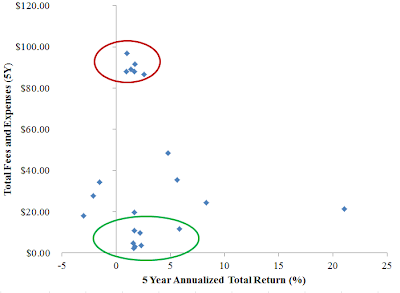Oppenheimer Fined for Complex Derivatives in Bond Funds
(Jun 2012)
In May 2010, SCLG released a paper on the Oppenheimer Champion Income Fund, detailing the complex derivatives transactions that led that fund to accumulate huge losses in 2008 compared to other high-yield bond funds. On Wednesday, the SEC charged OppenheimerFunds for material misrepresentations of these very risks in two funds, including the Champion Income Fund. OppenheimerFunds agreed to pay $35 million to settle the SEC's claims.
The funds, the Oppenheimer Champion Income Fund and the...
SEC Investigation into Largest Non-Traded REIT May Be A Sign of Things To Come
(May 2012)
As discussed in the financial press (see articles from InvestmentNews and Wall Street Journal) and the company's latest quarterly reports, Inland American Real Estate Trust is the subject of an ongoing SEC investigation. The SEC probe is determining whether the company incurred in any violations of the federal securities laws with regards to its fees, company organization structure, distributions paid to investors, and reported property impairments. Inland American is the largest non-traded...
Rehypothecation or Filched Fund?
(Apr 2012)
The investigation of the MF Global scandal is still ongoing. A lot of details concerning the missing customer funds haven't been revealed. At this stage there is no definitive answer as to whether MF Global blatantly transferred segregated customer funds to cover its own liquidity shortfall, or it merely used the often frowned-upon, but completely allowable practice of rehypothecation. In this blog post, I explain what rehypothecation is, as well as the controversy around it.
Rehypothecation...
High-Frequency Trading and Market Volatility
(Apr 2012)
The "flash crash" of May 6, 2010 -- when the Dow Jones Industrial Average dropped by 9% in a few minutes and quickly regained ground -- has naturally drawn wide attention. Although the sharp drop was not directly triggered by high-frequency traders (traders who execute trades based on complex algorithms and rarely hold a position more than a day), they have been blamed for fueling the selling after a mutual fund complex initialized a program to sell a large amount of E-Mini S&P 500...
Is There No Tracking Error for ETNs?
(Apr 2012)
Some investors may think that while ETFs are subject to various tracking errors, ETNs are not. The argument goes that index-tracking ETFs often hold part or the entire portfolio underlying their targeted index and are thus subject to imperfect tracking and transaction costs. ETNs, on the other hand, are debt instruments, and have returns guaranteed by their issuers.
It turns out, however, that the daily return of an ETN investment may not necessarily equal the leverage ratio times the daily...
A Primer on Investment Companies
(Mar 2012)
Investment companies are entities that issue securities and whose primary business is investing in securities. We have written about investment companies in several of our posts (See blog posts on ETFS and Mutual Funds). This post provides a quick introduction to investment companies and the securities they issue. The three main types of investment companies according to federal securities regulation are: closed-end funds, unit investment trusts, and open-end funds.
Some of the main...
Which Would You Rather Have?
(Mar 2012)
Last month we had a blog post introducing the FINRA Mutual Fund Expense Analyzer tool. In this post we apply it to the 25 largest mutual funds and ETFs measuredby net asset value using data from Morningstar. We assumed for this calculation an initial investment of $1,000 held for five years, and plot the total fees and sales charges over that period against the historical 5 year annualized total return of the fund:
There is no clear linear relationship between returns and fees as depicted in...
Hedge Fund Correlation with Broad-Based Indexes Increases Dramatically
(Mar 2012)
As Bank of America-Merrill Lynch Global Research's Mary Ann Bartels showed last year, the correlation of hedge fund monthly returns with broad based stock market indexes has recently hit historic highs. We decided to look into this phenomenon and determine whether or not it is persisting.
In the following plot, we show the monthly returns for the S&P 500 index as well as the Dow Jones Credit Suisse Core Hedge Fund Index (representing an aggregation of several hedge fund investment...
Downloading Price Quotes from Yahoo! Finance: an Excel-Based Tool
(Mar 2012)
Yahoo! Finance is a useful tool to get the latest quotes on various financial products. Although it is very convenient to see the price movement of the security of your interest (for example, IBM Stock) on Yahoo! Finance, it is somewhat more difficult to download the data into your own Excel spread sheet.
We recently designed an Excel template which allows users to directly download price data from Yahoo! Finance. You can download the tool from our website. To use the tool, simply call the...
Time to Call for More Transparency in ETF Market
(Mar 2012)
Exchange-traded funds (ETFs) started as a "plain vanilla" product: a type of low-fee, tax-efficient mutual funds holding index-mimicking portfolios. The first ETF was formed by the Toronto Stock Exchange in the 1980s and has garnered spectacular popularity in recent years. According to a recent article in The Economist, the number of ETFs in America has almost tripled from its 2006 level of 343 to 1,098 in December 2011. This volume increase has been accompanied by substantial financial...

